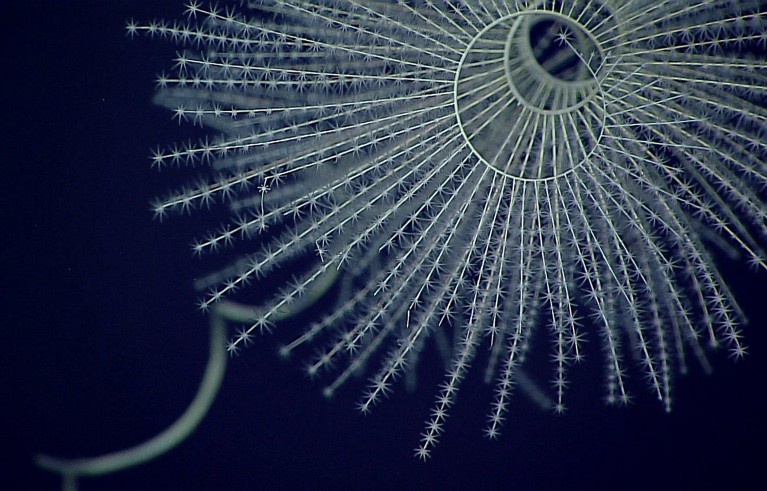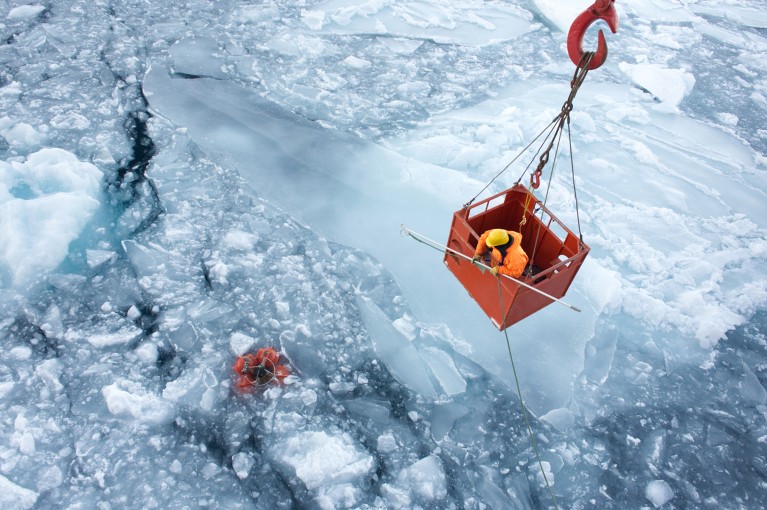[ad_1]
Hello Nature readers, would you like to get this Briefing in your inbox free every day? Sign up here.

A bioluminescent octocoral, Iridogorgia magnispiralis.Credit: NOAA Office of Ocean Exploration and Research, Deepwater Wonders of Wake
An ancient group of glowing corals pushes back the origin of bioluminescence in animals to more than half a billion years ago. “We had no idea it was going to be this old,” says evolutionary marine biologist and study co-author Danielle DeLeo. Tiny crustaceans that lived around 270 million years ago were previously thought to be the earliest glowing animals. Genetic analysis and computer modelling revealed that octocorals probably evolved the ability to make light much earlier, around the time when the first animals developed eyes.
Reference: Proceedings of the Royal Society B paper
A virulent strain of the monkeypox virus might have gained the ability to spread through sexual contact. The strain, called clade Ib, has caused a cluster of infections in a conflict-ridden region of the Democratic Republic of the Congo (DRC). This isn’t the first time scientists have warned that the monkeypox virus could become sexually transmissible: similar warnings during a 2017 outbreak in Nigeria were largely ignored. The strain responsible, clade II, is less lethal than clade Ib, but ultimately caused an ongoing global outbreak that has infected more than 94,000 people and killed more than 180. “The DRC is surrounded by nine other countries — we’re playing with fire here,” says virologist Nicaise Ndembi.
Reference: medRxiv preprint (not peer reviewed)
The World Health Organization (WHO) has changed how it classifies airborne pathogens. It has removed the distinction between transmission by smaller virus-containing ‘aerosol’ particles and spread through larger ‘droplets’. The division, which some researchers argue was unscientific, justified WHO’s March 2020 assertion that SARS-CoV-2, the virus behind the COVID-19 pandemic, was not airborne. Under the new definition, SARS-CoV-2 would be recognized as spreading ‘through the air’ — although some scientists feel this term is less clear than ‘airborne’. “I’m not saying everybody is happy, and not everybody agrees on every word in the document, but at least people have agreed this is a baseline terminology,” says WHO chief scientist Jeremy Farrar.
Reference: WHO technical report
Features & opinion
The development of lethal autonomous weapons, such as AI-equipped drones, is on the rise. “The technical capability for a system to find a human being and kill them is much easier than to develop a self-driving car,” says computer scientist and campaigner against AI weapons Stuart Russell. Some argue that accurate AI weapons could reduce collateral damage while helping vulnerable nations to defend themselves. At the same time, observers are concerned that passing targeting decisions to an algorithm could lead to catastrophic mistakes. The United Nations will discuss AI weapons at a meeting later this year — potentially a first step towards controlling the new threat.
In early April, the European Court of Human Rights ruled in favour of a group of more than 2,500 Swiss female activists aged 64 or over who argued that Switzerland was doing too little to protect them as a group particularly vulnerable to health effects stemming from climate change. “This marks the first time that an international human-rights court has linked protection of human rights with duties to mitigate global warming, clarifying once and for all that climate law and policy do not operate in a human-rights vacuum,” says legal scholar Charlotte Blattner, who advised the court. “The ruling is bound to alter the course of climate protection around the world.”
When US scientists needed a place to test the first birth-control pill, they looked to Puerto Rico. But many of the working-class women who took the pill were unaware that they were part of a clinical trial. Debilitating side effects were dismissed as psychosomatic. And when the final product came onto the market, it was too expensive for women like them to afford. The play Las Borinqueñas revisits this complicated history. “It’s a long-overdue tribute and, most importantly, a reminder to remain vigilant against abuse and disrespect in studies involving human participants,” writes Nature reporter Mariana Lenharo in her review.
Image of the week

Winning image: Glaciologist Richard Jones captured the moment a crew member on RV Polarstern prepared to rescue a measuring device trapped in ice.Credit: Richard Jones
This image, taken on top of the icebreaker research vessel Polarstern, shows the delicate process of retrieving an ocean-monitoring instrument called a CTD (short for conductivity, temperature, depth) that had become trapped under sea ice off the coast of northeastern Greenland. CTDs, which are anchored to the sea floor, measure how properties such as salinity and temperature vary with depth. The photo is the winner of Nature’s 2024 Working Scientist photography competition. See the rest of the winning images from the competition here.
Yesterday we told you that NASA had reconnected with its spacecraft Voyager 1, the first human-made object to leave the Solar System. But was it really the first? A reader question sparked a debate in the newsroom about whether that accolade should rightfully go to Pioneer 10.
A lot depends on how we define the edge of the Solar System, explains Nature reporter Sumeet Kulkarni. “But I think it’s safe to say Voyager 1 left it first,” he says. The craft overtook Pioneer 10 in 1998, and left the heliosphere — the reach of the Sun’s influence — in 2013, by which time it was travelling much faster than Pioneer 10.
Let us know how your journeys are progressing — and any other feedback on this newsletter — at [email protected].
Thanks for reading,
Flora Graham, senior editor, Nature Briefing
With contributions by Katrina Krämer and Sarah Tomlin
Want more? Sign up to our other free Nature Briefing newsletters:
• Nature Briefing: Microbiology — the most abundant living entities on our planet — microorganisms — and the role they play in health, the environment and food systems.
• Nature Briefing: Anthropocene — climate change, biodiversity, sustainability and geoengineering
• Nature Briefing: AI & Robotics — 100% written by humans, of course
• Nature Briefing: Cancer — a weekly newsletter written with cancer researchers in mind
• Nature Briefing: Translational Research — covers biotechnology, drug discovery and pharma
[ad_2]
Source Article Link

